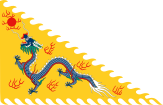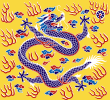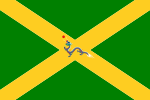 | |
| Yellow Dragon Flag (黃龍旗) | |
| Use | National flag and ensign |
|---|---|
| Proportion | 2:3 |
| Adopted | 1889; 136 years ago (1889) |
| Relinquished | February 12, 1912 (1912-02-12) |
| Design | Blue dragon on plain yellow, with a red pearl at the upper left corner. |
| Earlier version of Yellow Dragon Flag | |
 | |
| Use | State and war flag, state and naval ensign |
| Proportion | 56:87 |
| Adopted | 1862; 163 years ago (1862) |
 | |
| Use | Imperial Standard |
| Proportion | 56:87 |
| Adopted | 1862; 163 years ago (1862) |
| Design | The Imperial Standard for the Emperor of China |
The flag of the Qing dynasty was an emblem adopted in the late 19th century (1889) featuring the Azure Dragon on a plain yellow field with the red flaming pearl in the upper left corner. It became the first national flag of China and is usually referred to as the "Yellow Dragon Flag" (traditional Chinese: 黃龍旗; simplified Chinese: 黄龙旗; pinyin: huánglóngqí).
Ruling China from 1644 until the overthrow of the monarchy during the Xinhai Revolution, the Qing dynasty was the last imperial dynasty in Chinese history. Between 1862 and 1912, the dynasty represented itself with the dragon flag.
On January 10, 1912, the Yellow Dragon Flag was replaced by the Five-Colored Flag, and on February 12 Emperor Pu Yi abdicated, ending the rule of the Qing Dynasty.
Designs
Since the Ming dynasty, yellow was considered the royal color of successive Chinese emperors. Members of the imperial family of China at that time were the only ones allowed to display the color yellow in buildings and on garments. The Emperor of China usually used a Chinese dragon as a symbol of the imperial power and strength. Generally, a five-clawed dragon was used by emperors only.
In Chinese culture, a flaming pearl is shown on top of the dragon's head. The pearl is associated with wealth, good luck, and prosperity.
The design of the flag was largely based on the Plain Yellow Banner, one of three "upper" banner armies among the Eight Banners under the direct command of the Emperor of China himself, and one of the four "right wing" banners.
- The Eight Banners
The Eight Banners were administrative/military divisions under the Qing dynasty into which all Manchu households were placed. In war, the Eight Banners functioned as armies, but the banner system was also the basic organizational framework of all of Manchu society.
Triangular version (1862–1889)

The Arrow Incident of 1856 occurred as a result of Chinese civilian vessels flying foreign flags as the Qing dynasty had no official flag at the time. In 1862, sailors from the Chinese and British navies clashed at Wuhan on the Yangtze River. In response to protests from the British government that their ships were unable to properly distinguish between Chinese navy ships and civilian vessels, Yixin (Prince Gong) urged Zeng Guofan to create a governmental flag for the Qing, and suggested use of a yellow dragon flag, which was also used as one of the Eight Banners of the Manchu as well as in the Chinese army. After due consideration, Zeng Guofan concluded that a square flag bore too close a resemblance to the Plain Yellow Banner of the Eight Banners with the potential to be viewed as an endorsement of the Eight Banners hierarchy, he instead removed one corner to create a triangular flag.
The triangular version of the yellow dragon flag was restricted to naval and governmental use only, no civilian ships were permitted to fly the yellow pennant, and it never formally became the national flag. An exception was on 23 February 1873, when the regency of the Tongzhi Emperor ended and he assumed direct rule of the Qing empire. On that day all ships flew the triangular flag for the first time in celebration. Also on some diplomatic occasions and at international exhibitions, this flag was used to represent China.
Rectangular version (1889–1912)


In September 1881, when the two cruisers Chaoyong and Yangwei ordered from Birkenhead, England were sent to China, Li Hongzhang realized a triangular ensign was unique among naval flags of other countries. As a result, he petitioned the imperial court for permission and subsequently altered the triangular naval flag into a rectangular one.
Seeing Western countries flying national flags on official occasions, Li Hongzhang also asked Empress Dowager Cixi to select a national flag for the Qing dynasty. Among the proposals for use of the Ba gua flag, the Yellow dragon flag and the Qilin flag, Cixi selected the Yellow dragon design. In 1888, the imperial court promulgated the naval flag as the Qing national flag.
Influence




The notion of yellow as representative of Manchu ethnicity was used in the flags of the Five Races Under One Union flag of the Republic of China, and on the flag of the Empire of China, respectively, although in 1912 the former was challenged by Sun Yat-sen, who thought it inappropriate to use the traditional imperial color to represent Manchu ethnicity. Also, mustard yellow was used in the flag of Manchukuo in deference to the Qing dynasty, on whose flag it was based.
The blue dragon was featured in the Twelve Symbols national emblem, which was the state emblem of China from 1913 to 1928.
Naval flags of Qing dynasty
- Horatio Nelson Lay's Proposal (1862)
When the Qing dynasty purchased warships from the United Kingdom in 1862, Horatio Nelson Lay designed several naval flags based on the custom flag he designed. These proposals were not recognized by the Qing dynasty government.
- Beiyang Fleet (1874–1890)
The Beiyang Fleet was created in 1874, and several rank flags were introduced based on the traditional five color officials' flags of the old Chinese navy.
- Beiyang Navy (1890–1909)
The Beiyang Fleet became the national navy by Regulations of the Beiyang Fleet in 1888. However, rank flags were not updated until 1890, when William Metcalfe Lang and Liu Buchan disputed about their rank flags in an incident. Therefore, the British Royal Navy advisers proposed five new rank flags to replace the simple two rank flags system.
-

 Proposed Admiral's Flag
Proposed Admiral's Flag
-

 Proposed Vice Admiral's Flag
Proposed Vice Admiral's Flag
-

 Proposed Rear Admiral's Flag
Proposed Rear Admiral's Flag
-

 Proposed Commodore 1st Class's Flag
Proposed Commodore 1st Class's Flag
-

 Proposed Commodore 2nd Class's Flag
Proposed Commodore 2nd Class's Flag
However these proposals were not adopted by the Qing dynasty. New rank flags were introduced later in 1890.
- Imperial Navy (1909–1911)
After the total defeat of the Beiyang Navy in First Sino-Japanese War in 1894, the new imperial navy was reorganized following the establishment of the department of the navy in 1909. The Imperial Chinese Navy adopted the national flag in the canton of naval flags in 1909.
Flags based on the Qing dynasty flag
- Chinese Eastern Railway
The flag of the Chinese Eastern Railway adopted a combination of Qing dynasty and Russian flags. The flag was not updated until 1912.
See also
References
- "Dimension of first yellow dragon flag from Wuhan Custom Archive". Archived from the original on 2015-09-30. Retrieved 2016-06-30.
- "The Flag of China: The Story of Magic, Charm, and Legends". 2024-03-14. Retrieved 2024-09-24.
- ^ 施爱东 (Shi Aidong) (2011). Qing dragon flag flourished through 50 years of sorrow (哀旗不幸 怒旗不争 大清龙旗50年). 民族艺术. p. 6. (in Chinese)
- 肖吟新 (Xiao Yinxin) (2002). The story of the Qing dynasty national flag (清代国旗的故事). 世纪. p. 63. (in Chinese)
- "係為雇船捕盜而用,並未奏明定為萬年國旗", " is used for ferry and policing, but is not explicitly designated as the permanent national flag", from 《北洋水師章程》(Regulations of the Beiyang Fleet) (in Chinese)
- Morse, Hosea Ballou (1918). The International Relations of the Chinese Empire. Vol. II: The Period of Submission, 1861–1893. p. 266.
- "今中國兵商各船日益加增,時與各國交接,自應重定旗式,以祟體制。應將兵船國旗改為長方式,照舊黃色,中畫青色飛龍。", "Nowadays the number of both Chinese military and commercial ships is growing. When our ships meet those of other nations they should display a flag based on a conformed system. should change the military flag to a pennant with an azure dragon in the middle",《北洋水師章程》(Regulations of the Beiyang Fleet) (in Chinese)
- 《清朝国旗考》(Study on the Flag of Qing), 育民 (in Chinese)
- "Story of the National Flag, official website of the Kuomintang". Archived from the original on 27 May 2012. Retrieved 11 February 2014. (in Chinese)
- The London Gazette, 13 February 1863
- Lay-Osborne Flotilla (China)
- Drawings of the flags in use at the present time by various nations, Royal Navy Admiral
- Images of Chinese Naval Ships(1855–1911) / 中国军舰图志(1855–1911)" by Chen Rui 陈悦, ISBN 9787545811544
- 清国北洋海軍実況一班
- Source: 北京故宮《海軍旗式及章服圖說》 Archived 2014-01-09 at the Wayback Machine ("Illustration of Naval flags and Uniforms", Palace Museum, Beijing, China)
- Chinese Eastern Railway Company (China)
External links
![]() Media related to Flags of the Qing Dynasty at Wikimedia Commons
Media related to Flags of the Qing Dynasty at Wikimedia Commons






















